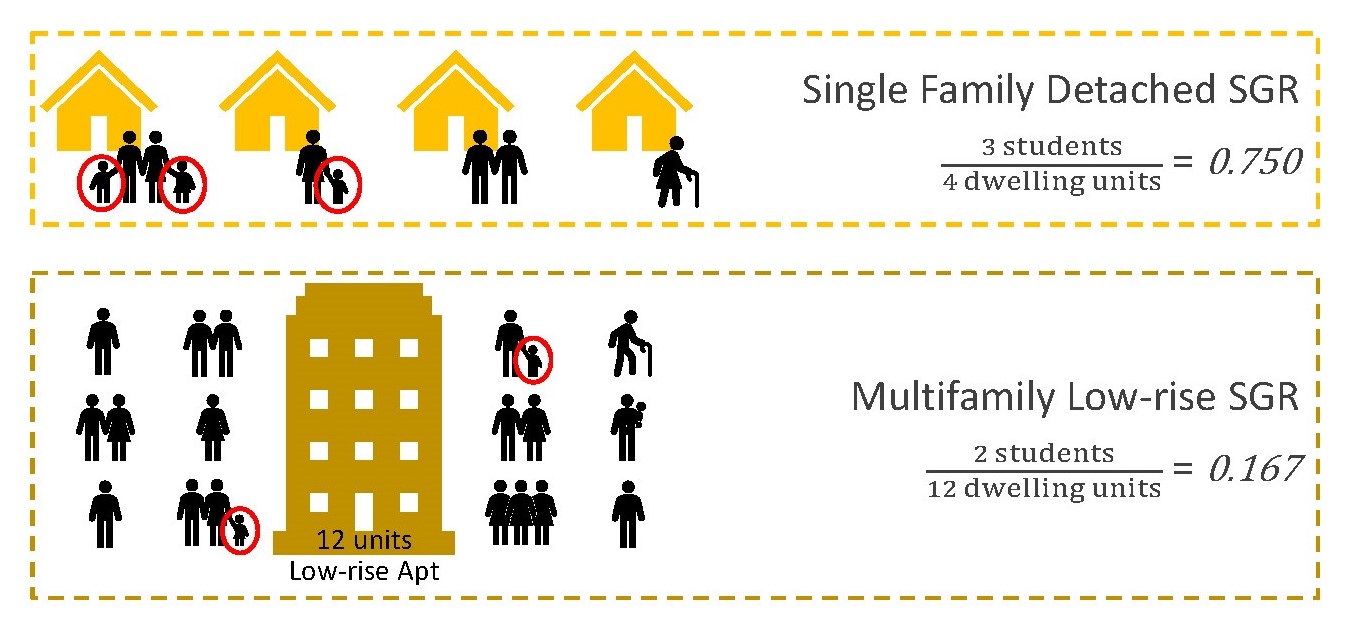Overview
| SGR = | number of students |
| number of residential dwelling units |
A student generation rate is the average number of students living in a particular type of residential unit for a given geography. It is used to estimate the number of public school students expected to live in a residential development.
For example, the student generation rates of the residential units below are:

The official student generation rates, updated biennially on July 1 of every odd-numbered calendar year, are established for each School Impact Area, by residential unit type (for multi-family housing types, only units in structures built since 1990 are considered). Since 2014, Montgomery County student generation rates have been calculated based on Montgomery County Public Schools’ official student enrollment and a housing dataset derived from the Maryland State Department of Assessments and Taxation (SDAT) property data. They are not estimates based on sample statistics but capture the county’s complete public school student population. The official rates are used to calculate the estimated impact of a residential development during the development review process, and to calculate school impact tax rates.
How does housing turnover impact student generation rates?
During the 2020 Growth and Infrastructure Policy (GIP) update effort, Montgomery Planning analyzed the student generation rates of single-family homes based on the year they were last sold, regardless of the year they were built. The graph below illustrates the finding that homes last sold in the past 15 years or so have noticeably higher student generation rates than the average rate of all single-family detached units. This supports the finding that the majority of enrollment growth in the county is coming from resident turnover of existing housing units. In the 2020 GIP update, Montgomery Planning found that 76.7% of the county’s public school enrollment growth was attributable to existing units. This also helps explain the ebb and flow of enrollment growth that many individual school service areas experience as residents in the surrounding neighborhoods turnover.
How did the student generation rates change in 2023?
MCPS’s total enrollment has not changed much compared to two years ago when student generation rates were last calculated. However, the distribution of students living in the various housing types has changed. In Turnover Impact Areas especially, single-family detached and single-family attached student generation rates fell by 1.6 percent and 0.4 percent respectively, while the multi-family student generation rates increased by 9.8 percent for units in low-rise structures (four stories or less) and 60 percent for units in high-rise structures (five stories or more). The student generation rates for multi-family housing in Infill Impact Areas also increased by 18.4 percent for low-rise structures and 14.1 percent for high-rise structures.
| FY 2024-2025 SGR | Change from FY 2022-2023 | ||||||||
|---|---|---|---|---|---|---|---|---|---|
| ES | MS | HS | K-12 | ES | MS | HS | K-12 | ||
| Turnover Impact Areas | Single-Family Detached | 0.185 | 0.102 | 0.154 | 0.440 | 0.0% | -5.6% | 0.0% | -1.6% |
| Single-Family Attached | 0.218 | 0.119 | 0.167 | 0.504 | -3.1% | -3.3% | 5.0% | -0.4% | |
| Multifamily Low-Rise | 0.116 | 0.061 | 0.081 | 0.258 | 8.4% | 5.2% | 15.7% | 9.8% | |
| Multifamily High-Rise | 0.073 | 0.042 | 0.053 | 0.168 | 43.1% | 75.0% | 76.7% | 60.0% | |
| Infill Impact Areas | Single-Family Detached | 0.202 | 0.096 | 0.141 | 0.439 | 3.6% | 0.0% | 1.4% | 2.1% |
| Single-Family Attached | 0.161 | 0.087 | 0.126 | 0.374 | -3.0% | -4.4% | 8.6% | 0.3% | |
| Multifamily Low-Rise | 0.065 | 0.030 | 0.040 | 0.135 | 10.2% | 30.4% | 25.0% | 18.4% | |
| Multifamily High-Rise | 0.039 | 0.016 | 0.018 | 0.073 | 14.7% | 6.7% | 12.5% | 14.1% | |
The increase in multifamily student generation rates is indicative of the current housing market. Since 2019, the average sold price for single-family detached homes has increased by 32%, and 18% for attached homes. Families are likely being priced out of single-family units and opting instead to live in less expensive multifamily units (or continue to live in them longer). However, multifamily structures still produce substantially fewer students on a per unit basis than single-family units.